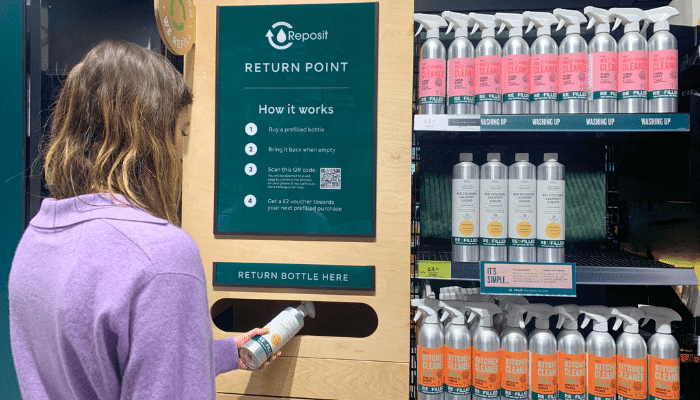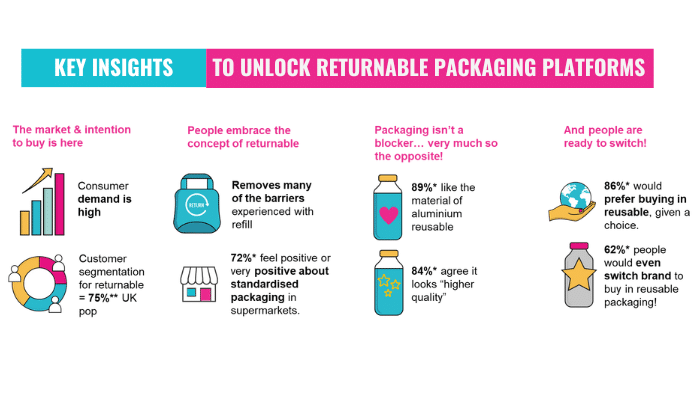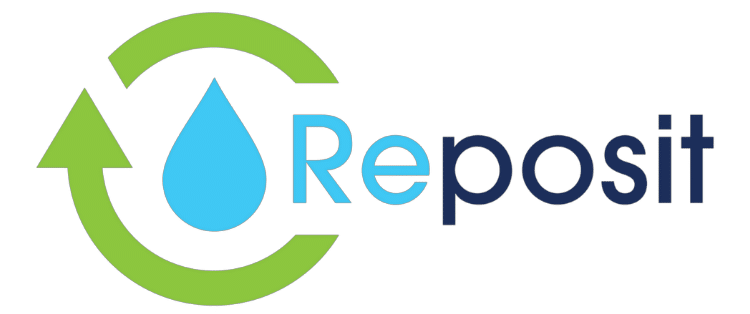BUILDING A REUSE & RETURN MODEL: Key Insights
Key insights to make returnable packaging easy for all, in collaboration with Reposit.
Together with Reposit, pioneers of returnable packaging platforms, we’re delighted to share key insights from our research to deliver returnable packaging at scale on the high street.
We believe collaboration is key to making refill and reuse accessible for all. That’s why it’s important for us to share our combined knowledge, providing practical advice to successfully launch reuse and return models.
If you’re a brand, a retailer, or a manufacturer who wants to cut packaging waste but doesn’t know where to start, we’re here to help. In this article we breakdown the key elements to consider.

BUT FIRST, WHAT ARE RETURN MODELS AND RETURNABLE PACKAGING?
Return models provide a new way to shop and reuse packaging. Consumers effectively shop a product in reusable packaging and return it after use when empty to be cleaned, re-filled, and redistributed with new products, again and again!
Supported by UKRI Innovate UK’s Smart Sustainable Plastic Packaging Fund, this research focused on the customer experience developed by Reposit, a first-of-its-kind returnable packaging platform. Together with M&S, they launched 10 homecare products (including laundry detergent, dishwasher liquid, cleaning sprays) in returnable packaging in various supermarkets in the UK.
⚙️ OUR RESEARCH APPROACH
Consumer behaviour is a crucial step to building viable return and reuse landscapes in retail, and identifying people’s needs and motivations to shift habits sits at its core.
We’ve worked with market research team Hitch Marketing on a matrix of methodologies to understand the customer perception of returnable packaging and getting key insights on the consumer journey of the Reposit solution in practice in retail.
We focused our work around 3 areas to establish our diagnosis:
- packaging perception (what they think of the product),
- messaging (how they talk about the product),
- and user journey (how they use the product).
The results were clear – consumers are ready for change!
💡 TOP 8 INSIGHTS

From the concept to the material, to purchase behaviour, our consumer research shows that people are ready to shift to returnable packaging.
1. Intention to buy is there – 69% of respondents indicated they are likely or very likely to try products in returnable packaging if they are available where they shop.
2. The market is bigger than you think – Three segments offer the greatest potential to grow reuse: Early Adopters (16%), Capable & Preparing (25%) and Ready & Contemplating (35%). Together, these groups represent more than three-quarters of the population.
3. Returnables remove many of the barriers experienced with refill: buying products in returnable packaging is seen as more familiar (than bringing their own container), easier, more convenient and helps ease concerns about hygiene.
4. People embrace the concept of returnables 72%* feel positive or very positive about standardised packaging in supermarkets. i.e. seeing various brands using the same aluminium packaging.
5. Packaging isn’t a blocker (in fact, very much the opposite!) 89%* of people surveyed liked the material of aluminium reusable and 84%* agree it looks “higher quality”.
6. Preference for reusable packaging: 86%* would prefer buying in reusable packaging, given a choice. The material is valued by consumers and returnable packaging can even elevate brand perception with new audiences!
7. People are ready to switch! Returnable appeals to a new audience: 62%* people would even switch brand to buy in returnable!
8. But don’t take our word for it, we heard people say: “This is aesthetically smooth and prettier…”, or “Modern, and I’d say unique…”

🔎 KEY LEARNINGS FOR THE FUTURE
Based on this research, we’re excited about the future of returnables. We’ll be particularly focusing on the following points in future surveys:
Make it good value for money
There is no denying that cost of living affects all regions and all customer segments. Our solution must be good value for money.
Respondents value incentives like ‘rewards’ highly as a driver to return their empty bottles: some of the most popular incentives we found in our research included loyalty points, vouchers, and communicating the lifecycle of our packaging.
Make it as easy as possible.
Convenience and ease are critical to build consideration to purchase. Communication plays an important role to make the experience as easy as possible!
When our respondents went through the return process, they shared how easy and quick it was. We found that consistent messaging alongside easy step-by-step process help people to follow and to take part in the solution.
Ultimately, it’s about making the return process accessible to all: by making the solution available where people shop, and developing a return points network so that people can shop and return their returnable packaging anywhere.
Make it attractive
The same as for any other product, disrupting the shopper journey is a crucial step for behaviour change. In our in-store research, we have observed that the aluminium material catches the eye as it looks “different” and “modern”.
This is where POS material plays an important role to disrupt the auto-pilot mode from shoppers and educate around reuse.
The power of data and impact
Sharing the impact that user can have and how they are making a difference can encourage trial. Our qualitative interviews showed that people are interested in understanding the whole system, e.g. what happens to the bottle after it’s being returned, and the impact they can have.
We found this insight truly encouraging as it proves that people want to make a difference and are ready for change. A point that is confirmed by the recent article from the Harvard Business Review: “Consumers value a product more highly when it is part of a take-back program because it shows greater sense of “psychological ownership” control knowing what happens after they return the bottle.”

We’re here to help
If you want to reduce packaging waste but don’t know where to start, Reposit and City to Sea are here to help.
City to Sea works with brands and retailers to drive behaviour change solutions and research for long lasting impact. We have first-hand experience of running a returnable coffee cup scheme, and capitalise on 9+ years of consumer insights in the reuse and environmental space . Get in touch to find out more about how we can help you transition to reuse.

Reposit is on a mission to change the way we deal with packaging. With a particular focus on fast-moving consumer goods (FMCG) products, Reposit delivers a returnable packaging platform that works at scale for all stakeholders.
Contact the Reposit team for practical support and learn more about the solution in place.

GET THE LATEST FROM OUR BLOG
Introducing Refill Return
Our award winning Refill campaign has evolved. Refill Return is our future-ready to reflect the demands of the circular economy.
Chew Plants Not Plastic
Chew Plants Not PlasticA Call to Ban Plastic-Based Chewing GumDid you know most chewing gum contains plastic? Yes, that piece of gum in your mouth is actually made from the same plastics found in carrier bags, shampoo bottles, and even car tyres. And we brits chew a...
Shoppers Want Reusable Packaging to Tackle Single-Use Waste
Shoppers Want Reusable Packaging to Tackle Single-Use Waste – Here’s Why At City to Sea, we're on a mission to tackle single-use plastic waste, and it’s clear the public is right behind us. Our latest poll reveals that a massive 75% of UK public believe reusable...




